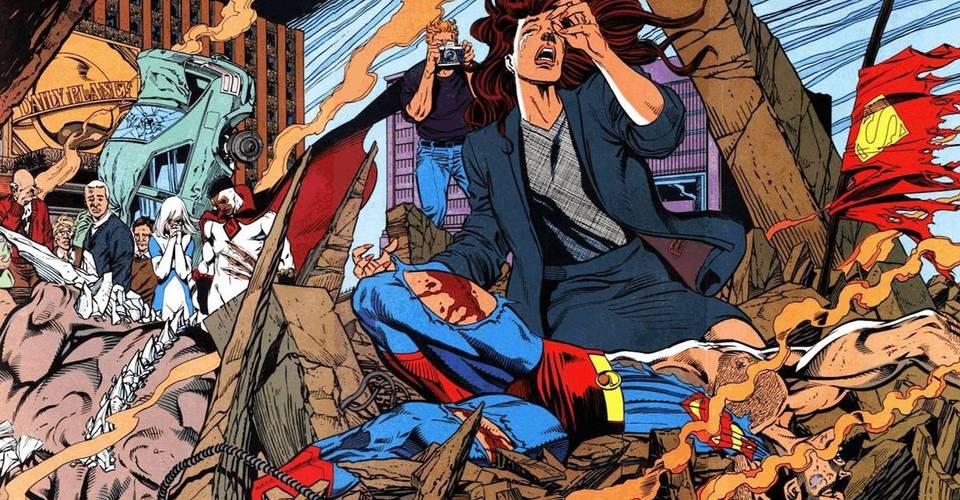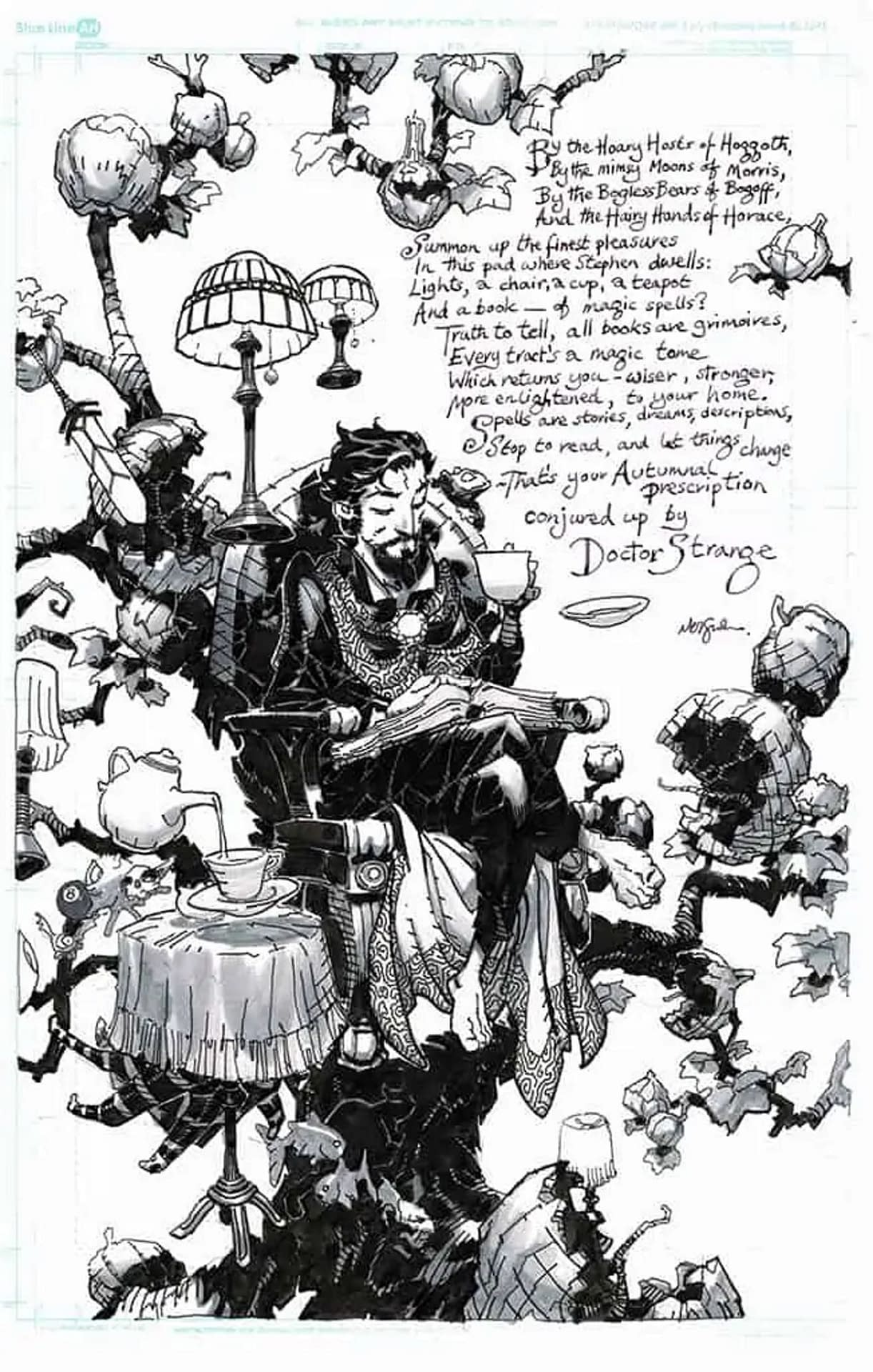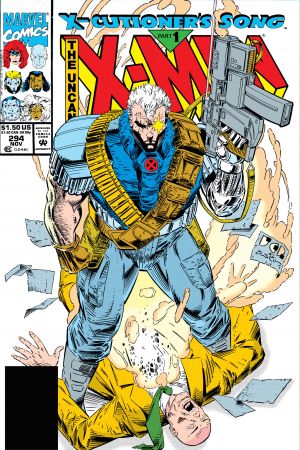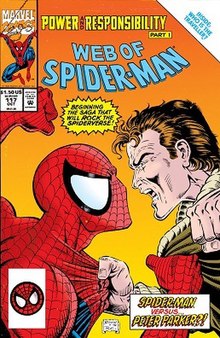Part IV: Darkness Rising (Cont’d)
From Pow! An Illustrated History of American Comics from the Victorian to the Modern
By the early 1990s the Dark Age of Comics, for those who recognize it, was in full effect[1]. It was the era where Venom got his own print while Aunt May died, where Superman would pursue a revenge quest following the near-death of Lois Lane, Hellspawn would launch, and gun-toting, casually-violent antiheroes would take center stage away from the Caped Crusaders.
And best of all it’s the era when everyone’s favorite Mouthy Merc would appear, forever making comics a better place for everyone.
Like comic’s awkward adolescence, it was a period ironically marked both by more adult themes, and by more juvenile fantasies. We’d see many of the favorite old school characters like Peter Parker retire while Eddie Brock would go on literal rampages. Antiheroes began to get more overtly hypermasculine and violent, even as the trend towards such musclebound killers was fading away in films. The more mature themes of the Bronze Age evolved into more overt pushing-the-limits on sex, drugs, and graphic violence.
And it was really freakin’ funny and awesome. Especially when you-know-who did it.
It was also the era of the Comic Book Speculator’s Market, which saw the hoarding of comic books and the creation of numerous “event comics” to capitalize upon it. Numerous fans bought numerous copies of comics and filed them away, hoping for them to gain value over time, which might actually have happened if everyone else wasn’t doing the exact same thing. It was the era where less scrupulous producers even used limited print runs and forced scarcity to create demand
the magnificent bastards. Ironically, it was these more manipulative forced scarcity efforts that actually managed to produce works which could grow in value over time, though not to the degree that their keepers hoped.
In many respects the Dark Age, or early Iron Age if you prefer,
I thought you said it was the Bakelite age? was a natural evolution of the Bronze Age, continuing to explore more mature themes and pursue more adult audiences in the absence of the Comics Code. It experimented not just with more controversial subjects, but also explored new art styles, new technologies like digital inking and coloring, and new storytelling techniques.
Don’t forget fourth wall breaks! This led to a strange juxtaposition where the same comics lines could feature deep explorations of the philosophy of crime and punishment…and then turn into a gratuitous splatter-fest.
Dark Horse Comics came into its own in this era, distributing not just movie-based lines like
Alien vs. Predator, but distributing indie artists like J. O’Barr, whose goth-inspired
The Crow would feature in his own film, directed by Sam Raimi. Frank Miller’s
Sin City and
The 300 would debut, as would the insane Doug Mahnke series
The Mask and the punkish Jamie Hewlett and Alan Martin comic
Tank Girl, both of which also became movies later in the decade. But it would be Mike Mignola’s
Hellboy who would have the most lasting impact, appearing in 1993 and redefining what a superhero could be. Mignola, Hewlett, Miller, and O’Barr also broke new ground artistically, each having an unmistakable signature art style that stood out in a world defined by classic DC and Marvel stylings.
The UK comics magazine
2000 AD continued to expand the Judge Dredd character, featuring the popular “The Dead Man” storyline, which saw the titular Judge coming to terms with mortality and beginning to question his purpose. They expanded with strips like
Firekind and
Sinister Dexter[2]. 1993 also saw the “Summer Offensive” where comics writers including Grant Morrison and Mark Millar were given free rein to write whatever they wanted, resulting in some truly insane works like “Big Dave” and “Slaughterbowl” where convicts ride dinosaurs into battle against each other.
But, needless to say, it was the “big boys”, Marvel and DC, who made the biggest impact on the Age.
DC, post-crisis and under the increasing supervision of their bosses at Warner Brothers, was having a crisis of identity itself. Writers like Alan Moore, Neil Gaiman, and Grant Morrison were adding depth and darkness, with Morrison’s take on Batman following on from Frank Miller’s earlier dark, gothic take exemplified in
The Dark Knight Returns. Morrison’s turn on Batman became very popular and a source of inspiration for other dark vigilante characters of the age, and given the success of the Raimi Batman films and the Bird Brain Batman animated series, Morrison was at first given a lot of leeway to continue this darker tone, not just with Bats, but with the whole of the Justice League, rebranded as the “JLA”. This would reverse itself when
that asshole John Peters became an executive in 1994 and along with
prick producer Tom Rothman pushed for more “toyetic” work even as they simultaneously pushed for more of the “dark, grown-up stuff the nerds like”.
Like this, but the other way around! (Image source Screen Rant)
Superman would be the ultimate victim of this schizophrenia, and rumor has it that they almost killed him off.
But they didn’t, the cowards! Instead, Sups entered the decade with the promise of good times ahead, proposing to Lois Lane and becoming engaged, outwardly as Clark Kent. Clark and Lois marry in 1992's Superman (vol. 2) #75 in a big Event Comic that became a major source of financial speculation at the time.
However, marital bliss was not in store for our classic lovers, instead introducing the character of Kenny Braverman, a.k.a. Conduit, whose powers were granted by the crash landing of Kal El’s space cradle, flooding him with radiation and allowing him to emit Kryptonite radiation. Formerly an abused child, Conduit, who blames Kent for his hard life, attacks the wedding ceremony, apparently killing Lois Lane (her fate left as a shocking cliffhanger). While Lois would end up on life support, Superman would watch as Conduit attacks his family and friends, burning the Kent homestead to the ground and kidnapping Lara Lane. This sends Superman on his controversial hunt, dubbed a “revenge quest” by comics fans, where he openly considers killing Conduit for the “
greater good”[3].
(Image source Den of Geek)
Also at DC, the adult-themed Vertigo line was continuing to push the limits of what could be in a comic, with Gaiman’s
The Sandman continuing its iconic run, taking Morpheus, the avatar of Dream, deeper into existential exploration and into reckoning for his past actions. It was the Goth Culture scene made manifest and was in many ways the poster child for what the Dark Age could be when allowed to move beyond puerile wish fulfilment.
But let’s face it, Morphy was kind of a self-absorbed tool. Morrison would take an occasional break from
JLA and
Batman to provide some Vertigo titles, such as the Steam Romance
Sebastian O. and the Phillip Bond collaboration
Kill Your Boyfriend.
Like this but far sooner! (Image source Bleeding Cool News)
Gaiman would continue to support
The Sandman line through to its conclusion, but remained a freelancer, ultimately simultaneously contracting with rival Marvel following his work with Tim Burton. This of course led to the popular
The Mighty Thor: A Debt to the Norns storyline, which delved deep into some of the more twisted and family-unfriendly aspects of Norse mythology, and to the now-iconic “Infinite Regressions” storyline for
Dr. Strange, which introduced the idea of Dr. Spektor (who was acquired with Gold Key) as the human avatar for a trans-dimensional incorporeal being attempting to forge an alliance with the Sorcerer Supreme as it battled Lovecraftian Horrors “beyond Cartesian reality”. The latter storyline remains a favorite of fans and academics alike, the latter in large part due to how it delved into intellectual subjects like quantum physics, fractal math, and Fibonacci ratios. This mathematical-metaphysical mix was reportedly influenced by Gaiman’s Skeleton Crew collaborations with Tool front man Maynard James Keenan[4].
Alan Moore, who is largely credited with initiating the Dark/Iron Age, would be lured back to DC after they allowed the rights to
The Watchmen to lapse and gave him, via Vertigo, the green light to launch his
Twilight of the Superheroes line, an alternate world where superheroes have forged ruling dynasties. It all leads to a Götterdämmerung style ending that sees the fall of many of the most famous DC heroes from Superman and Wonder Woman to the entire Marvel clan. Despite being a parallel world, the cynical, deconstructive, and misanthropic take on the beloved heroes created shock in the industry and fandom alike. It remains Moore’s most controversial work.
Frank Miller, who along with Moore is credited with launching the Dark/Iron/Bakelite Age, would by contrast leave the major labels, completing his
Elektra Lives line for Epic, and then going freelance himself. For Dark Horse he’d produce such memorable works as the Noir-tinged
Sin City and the historical epic
The 300, as previously mentioned.
Hey, baby, wanna Spawn?
In Marvel, by this point firmly a part of the Disney empire, Jim Shooter was in charge and, with Disney keeping the lights on and CCO Jim Henson happy to give them the creative freedom they sought, he opened the door for his writers to push the limits. The Epic line, largely rebranded into an adult line to compete with Vertigo, became the home for some of Marvel’s new wunderkinds like Dale Keown, Todd McFarlane, Art Adams, Jim Lee, Erik Larsen, and Rob Liefeld. 1993 for example saw the launch of McFarlane’s now-iconic
Hellspawn, which followed Al Simmons, a CIA assassin who dies, goes to hell, and is “recruited” against his will as a “Hellspawn”, or knight in Mephisto’s service.
Hellspawn rivalled Venom
and everyone’s favorite Merc as the poster child of the Dark/Iron Age. Violent, ruthless, cruel, ugly, conflicted, and angst-ridden,
Hellspawn set the tone for the dark, tortured antiheroes to come. The comic sold like crazy, eventually spawning
(pun totally intended, I’m sure) a movie. Featuring McFarlane’s flowing, dynamic art,
Hellspawn was also one of the first Marvel comics to use digital inking and painting using the DIS Stations, pushing the technical as well as thematic bounds of the medium. It also gained the ire of the moral guardians, despite being a part of the adult-focused Epic line, who blasted it for “glorifying Satan”, despite the fact that Simmons’ fate is hardly portrayed as a “good thing” for him.
Seriously, did those assholes even read it?
Other Epic lines pushed the limits in similar ways. Shooter, Steve Englehart, and artist David Lapham’s
Shadowman and Bob Layton and Bernard Chang’s
The Second Life of Doctor Mirage both spun off from Dr. Strange and dipped into necromancy and other “darque” magics. Erik Larsen’s
The Savage Dragon, a character he developed as a child, incorporated Cowboy Cop tropes and made the titular character an actual Chicago Police Officer rather than a masked vigilante. The Wachowski Siblings (writing as Larry and Andy at the time
I love you either way, sisters!) would start their careers at Marvel, writing for
Ectokid and Clive Barker’s
Hellraiser and
Night Breed for Epic.
(Image source Marvel.com)
Rob Liefeld also began to make an impact at Marvel and Epic, where his exaggerated forms and anatomy-defying poses became indelibly linked to the Dark/Iron Age. While often the butt of snark later, Liefeld is credited with launching some of the most famous characters and storylines of the Age, including Cable (with Louise Simonson) and Youngblood. His second most famous creation of the era was the foul-mouthed, gun-toting, rageaholic
Shooter Jim, obviously based on Marvel President Jim Shooter, who at this point in his career loved to play the “bad cop” to Chairman Stan Lee’s “good cop”[5].
His less-famous characters, like the maligned Deathstroke rip-off Deadpan, whose attempts at being “stoic” in an “Eastwood-like” manner came across as “dull”, largely faded into obscurity, however.
And who can forget his greatest creation, the beloved Merc with the Mouth, Deadpool! Sure, it took the genius of Joe Kelly to truly unlock his hilarious potential and free him from the confines of the page, a self-aware Meta Character who, by not being bound by print, was in reality a God among mortals. Is it any wonder why he is so universally beloved?[6]
And in a sign of just how insane the Age was, influenced by McFarlane and Liefeld, Joe Kelly took the relatively minor DC character of Ambush Bug and made him self-aware, a fourth wall breaking wiseass who gained a huge cult following specifically because of his medium awareness[7].
Liefeld and McFarlane largely set the tone for the age, with weapons getting larger, antiheroes getting more grimdark, and morality getting slipperier, with even Spiderman and Captain America taking darker turns at various points. The appearance of the alien symbiote and Venom marked a darker turn for Spider-Man in particular, and many on the staff were nostalgic for the “Spidey of old”, who’d lit up the Big Screen by this point. Thus, Peter Parker was given some time off, marrying Mary Jane and having a son together (reportedly in response to the
Marriage of Superman) while his Clone Ben Reilly from
The Amazing Spider-Man #149 takes over as Spider-Man. The decision to retire Peter Parker was a controversial one, and some in the editorial staff objected, in particular editor Bob Budanski, who wanted to find a way to revert back to Peter, but DeFalco as Marvel Editor in Chief and Shooter, as the “final authority”[8], stuck to the script, particularly once it was discovered that Disney CCO Jim Henson liked the idea of Peter and Mary Jane having a “well-earned happy ending”.
While old comics fans were divided, with many writing angry letters,
the crybabies no kidding, the “reset” allowed a “way in” for the many new readers who first discovered and fell in love with Big Screen Spidey, even as the Ben-Peter dichotomy caused some early confusion. Further controversy followed with the death (albeit peaceful) of Aunt May.
Spider-Man: The Final Adventure would debut in late 1994, ending with the ironic death of the Gwen Stacey clone
who started the whole Clone mess in 1970 and the birth of Peter and Mary Jane’s son, Benjamin Richard Parker. The Fandom and Marvel staff alike split into “Peter” and “Ben” factions, but for the time being, Ben was Spidey while Peter would remain “retired”, returning on occasion to help out or mentor Ben[9].
Spiderman, meanwhile, continued to cross over into other Marvel and Epic comics lines, getting pulled into the Age of Apocalypse crossover with the many X-Men lines along with the Fantastic Four and The Avengers. The Age of Apocalypse crossover led to increasing morally gray actions as the various factions competed, with the fate of the Universe in the balance. While originally happening in the core Earth 616, it later got Retconned into its own Earth 336 since the massive fallout of the series, which resulted in the shocking deaths of many favorite characters, would have been a mess to straighten back up.
Meanwhile, Shooter pushed to relaunch many of the old Gold Key and Harvey characters, recruiting Barry Windsor-Smith and Bob Layton to relaunch
Turok, Dinosaur Hunter;
Magnus, Robot Fighter; and
Solar, Man of the Atom, the latter two of which were given a retro-futuristic makeover. They also launched new lines like
Harbinger,
Ninjak, and
Bloodshot[10].
View attachment 698956
(Image source “valiant.fandom.com”)
Magnus, meanwhile, served as a vehicle for an all-new Marvel 4000 series[11], which took the many Marvel characters, or at least their descendants and inheritors, into the far future year of 4000. Magnus becomes a darker character in a dystopian, cyberpunkish future world where environmental degradation has left the planet scorched and lifeless and overharvesting has left natural resources exhausted. Robots rule space around Earth where they deliver celestially-mined resources to the Bot-ruled territories on earth that the non-bot-ruled areas have to steal in Viking-like raids in order to survive. Humanity is squeezed into “megopolis” city states, each with its own politics and culture, some bot-ruled, some not. Magnus’ megopolis is ruled by robots alluded to have been built using modified plans for Ultron, but programmed to care for humans and protect them at all costs. And while this seemed like a good idea at the time, is devolved quickly into a Crapsacharine arrangement where humans are kept like pets or cattle, the Bot's original "three rules" style programming skewed into something super-patriarchal.
Eh…we’re kind of asking for it. Magnus and a few others have risen up against it.
The success of the Magnus reboot led to the launch of the Marvel 4000 line, with other megopoli introduced in other titles. One megopolis sees the “Old Heroes” of the Avengers, Fantastic Four, and X-Men are revered as gods and Humans and Mutants living peacefully together, but with residual animosity as resources are short. Another megopolis is ruled by totalitarian Mutants following the edicts of the Brotherhood of Mutants, with a hereditary supreme ruler who claims divine descendance from Magneto. Later titles introduced where Space has gone, with the Silver Surfer, further radicalized by the death of Galactus, leading a brutal war of terror against the robots allied to an older and mentally damaged post-Ragnarök Thor.
The Magic Realm even had its own fight as techno-wizardry allowed necromantic cyborgs to blur the lines between bot, zombie, and mage. Necropolis, for example, was introduced as a “necro-techno-wizardry” city of bones (the fandom dubbed it “Zombie Borg Land”). Dr. Strange, Dr. Spektor, and the future Sorcerer Supreme, the magically-cybernetic Eterias, are leading this fight.
Like the Age of Apocalypse, the Marvel 4000 line would ultimately be retconned into its own Earth 4000 setting.
The setting of Marvel 4000 of course reminded the publishers of
2000 AD a little too much of the setting for
Judge Dredd, leading them to consider a lawsuit.
Who didn’t see that coming? Instead,
2000 AD partnered with Dark Horse and began distributing in North America, making the Judge Dredd character in particular better known in the States, where some ironically considered him a Magnus and Punisher rip-off. In response, Dredd creator John Wagner decided to launch Judge Dredd’s famous (and slightly tongue-in-cheek) “Copycat saga”, whereby a mad scientist named James Magnuson creates robot copies of the Judges in an insane attempt to replace them all and thereby rule the Mega Cities himself. Modeled on Jim Shooter, the character managed to be the second 1990s character after the Liefeld character based on the influential Marvel President.
And if that doesn’t tell you how much influence Jim Shooter had on the Dark/Iron Age, then nothing will.
Eh, I find him overrated.
Totally.
Oh, shut up, Bug.
You know you love me!
[1] Massive, multiversial crossover hat-tips to
@nick_crenshaw82,
@Ogrebear, and
@Pyro for the assist in this article. The Deadpool fourth wall vandalism was all me
no me, though, so don’t
blame thank them.
[2] A brilliant title for those who know their Latin!
[3] This idea courtesy of
@Pyro (hat-tip!). For those wondering what happens, in Pyro’s own words: “Eventually, Conduit lures Clark to a mock version of Smallville filled with android duplicates of its inhabitants programmed to despise him. Superman and Conduit face off in the football stadium. While the two start on fairly even terms with Conduit's Kryptonite blasts weakening the Man of Steel, Superman's rage eventually overcomes them and he tears off Conduit's armor before readying the final blow...only for Batman, Wonder Woman, Green Lantern (Hal Jordan), and members of the Justice League to arrive with a recently-recovered Lois. She pleads with Clark to spare Conduit's life as the Superman she loves would never take the life of another, [and he spares Conduit] when he realizes how far he's gone. However, just as the two walk away, Conduit breaks loose from the Justice League's restraints and activates a self-destruct in a last-ditch attempt to take out his hated rival for good. Superman shields Lois from the blast, but the Kryptonite radiation saturated his cells and left him temporarily powerless until his body absorbs enough solar radiation to filter out the Kryptonite [ultimately] leading into ‘Reign of the Supermen’ where several new heroes appear in Metropolis to fill the void left by the powerless Superman like Steel, Superboy, and [even] a ‘reformed’ Lex Luthor.”
[4] More on this madness to come.
[5] While Shooter has adopted a lot of Henson’s lessons on talent management, he’s still Jim Shooter.
[6] Wade, you’re butterflied! Get the hell out of my timeline!
Ha, nice try, asshole! You ain’t gonna butterfly me!
My Timeline. You’re butterflied. Period.
Nuh-uh! 
[7]
Hey! I deleted that section!
I rewrote it. Salute to @nick_crenshaw82 for thinking of me, by the way.
Ambush Bug? I’ll totally squash you.
Face it, DP, I’m the fourth wall breaking wiseass of this TL! Butterflies are a bitch.
This ain’t over, Bug.
[8] With Disney underwriting everything, there will be no “five editors-in-chief” mess, with each trying to outdo the others, and no favoritism or sabotage between lines.
[9] Yes, the original plan goes through. No “Maximum Clonage”.
[10] Needless to say, the Image and Valiant Comics lines are Marvel lines in this timeline.
[11] Hat tip to
@TheIdiot224 for this idea. This will replace Marvel 2099.












